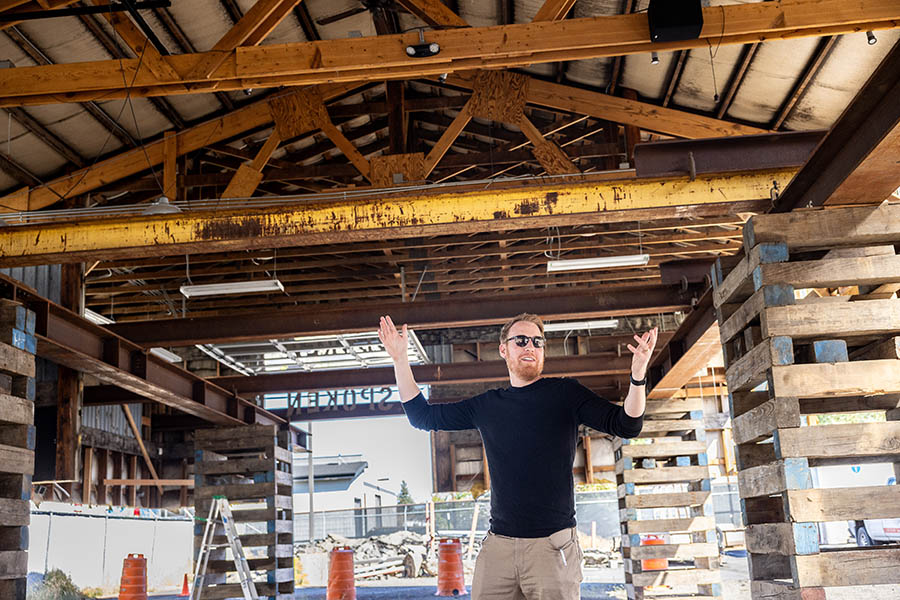A $200 million revitalization effort in the heart
of Bend signals the end of urban adolescence.
For a city as polished as Bend, the centrally located intersection of Northeast Second Street and Northeast Hawthorne Avenue stands out for its grit. Here, less than a mile from the boutique stores and $60 entrees of downtown, there are no blocks of twinkling structures boasting walls of expensive glazing. The streets that lead to this spot are weathered and rough with weeds exploiting the gaps. Stepping out of your car carries a whiff of urgency to be gone by nightfall. There are makeshift camps. People sleep on sidewalks.
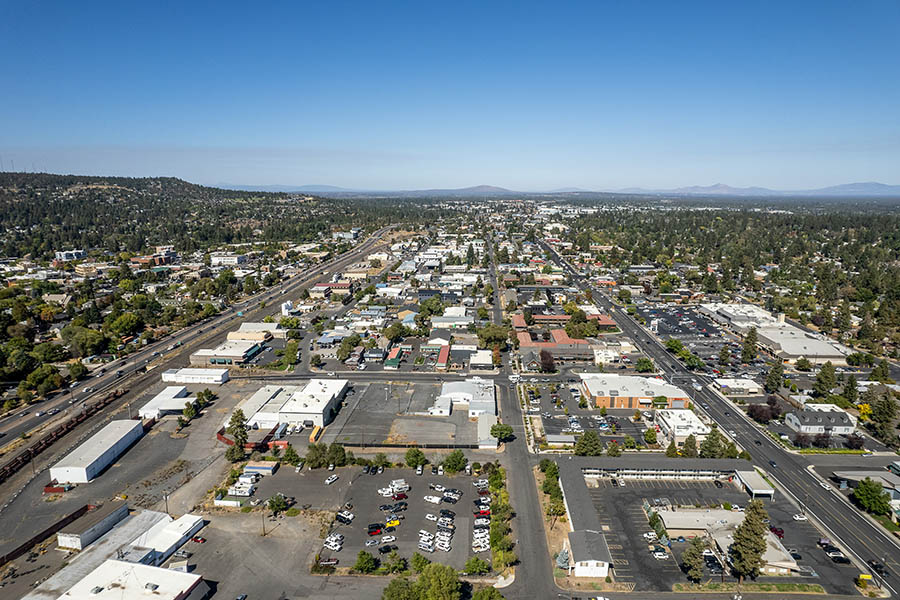
No, this is not the Bend of magazines and sunny tourist weekends. It is the underbelly of a rapidly growing city grappling with its neglected parts.
But this corner, which also houses a BottleDrop recycling center and a hip hotel barricaded by a chain-link fence, sits at the geographical heart of one of the city’s most ambitious attempts to reimagine its urban core since the timber industry’s collapse. Dubbed the Bend Central District (BCD), this 196-acre light-industrial area, roughly defined by Northeast Fourth Street to the east and the U.S. 97 parkway and BNSF railroad tracks to the west, is well on its way — and not just on paper — to becoming a new commercial and residential core.
When fully built out sometime in the next 30 years, the BCD will be home to nearly 2,000 new housing units — a 10,000% increase over what’s there today. Businesses will have thousands and thousands of square feet dedicated to commercial and office space, which will be enough for nearly 10,000 workers, a 385% leap from today. There could be theaters, community art spaces and even child care facilities. All of this will be linked by walkable, bike-friendly streets lined with greenery, pocket parks and pleasing lights right in the heart of town.
“Bend is on the precipice of great change,” says Corie Harlan, the cities and towns program manager for Central Oregon LandWatch, a nonprofit that has made unlikely alliances with developers interested in the area — the group’s preferred location for growth instead of pushing out into Bend’s urban-growth boundary. “We’re all just waiting for that first domino to fall,” she says.
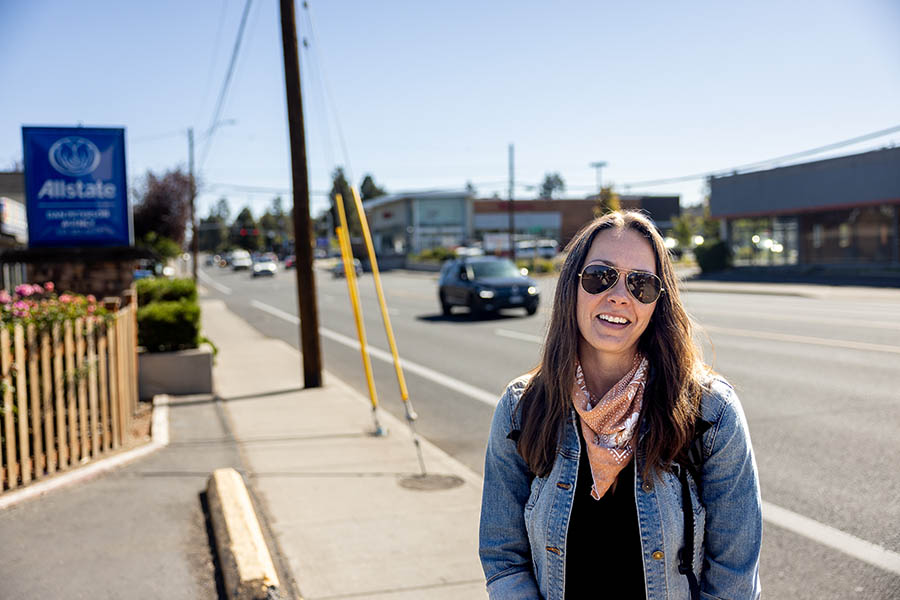
That first domino will likely be a large-scale residential project, two of which are well on their way through the design and permitting process. Combined, the two projects would bring more than a quarter of a million square feet of apartments and studios into the core area. “We need people to call this district home,” Harlan says. “Once that happens, I think everything will happen.”
The scope of what’s happening across the entire district is staggering, even for Bend, a city that ballooned to 99,200 people in 2020, a 33% increase from the 2010 census. Roughly two years in, a new urban-renewal district has already redirected increases in property taxes through a tax-increment financing scheme into a $1.4 million coffer for improvements in the area. The total TIF amount could reach as much as $195 million by around 2050. Along with grants and public funding to tap, early-phase plans call for $60 million in revitalization projects that will include a bike-pedestrian bridge that will arch over the parkway and railroad tracks to link the BCD with downtown to the west, a move that will literally, as well as symbolically, bridge an east-west divide that has long plagued the community.
Taylor Development, Brooks Resources and Project PDX have snapped up desirable properties with intentions of constructing mixed-use buildings that will likely take advantage of rules that allow increased building heights of up to 85 feet and reduced-minimum on-site parking requirements. Main east-west connector streets like Greenwood Avenue and Franklin Avenue will be redesigned and spiffed up with strollable underpasses, sidewalks and greenery to slow traffic and encourage more walking, cycling and lingering. If all goes as planned, the BCD over the next three decades will transform itself into something akin to Portland’s Pearl District, an urban-renewal area that embraces its industrial character while providing services, entertainment and homes for a wide range of income levels.
“Bend is yearning for a place that feels real to the touch rather than the tourist-centric spaces where everything is prim and proper,” says Kurt Alexander, a developer and co-founder of the Bend Central District Business Association, a nonprofit championing development in the district. “We want to lean into it being more rugged.”
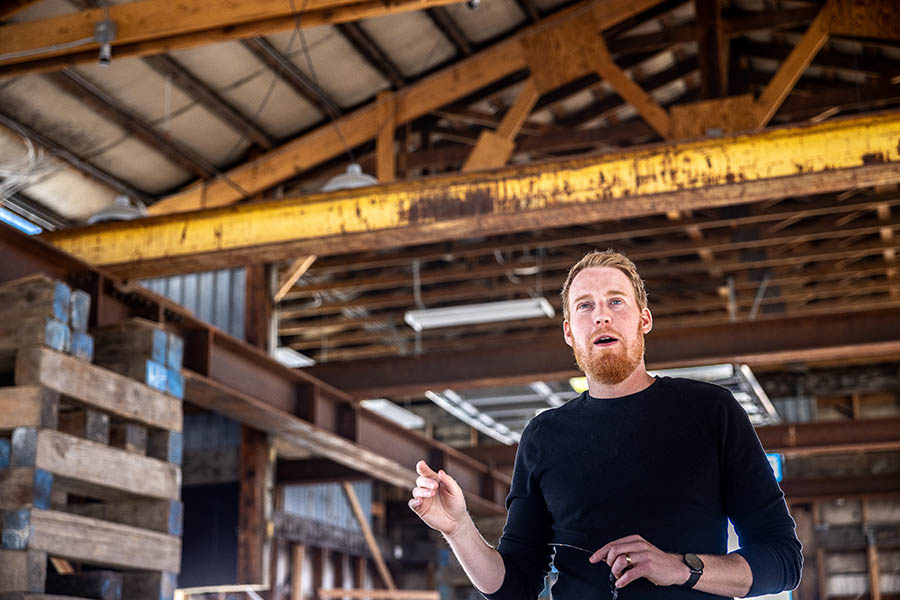
On a recent afternoon, Alexander, the principal behind Petrich Properties, showed a visitor around a portion of the district, which is indeed rugged. A man with skin baked to elephant hide dozed in a patch of cheatgrass between two distressed parking lots. Across the street sat an incongruous but well-kept single-family home that Alexander owns and jokingly — and quite affectionately — calls his “crack house.”
“There’s so much trash and debris and needles and feces,” says Tod Breslau, the owner of the hip Campfire Hotel on Northeast Third Street, who also built Portland’s Jupiter Hotel. “We are constantly using the police non-emergency number.”
But that hasn’t deterred people like Breslau and Alexander from charging ahead with a dream for what the district stands to be. It’s a vision that started when Bend expanded its urban-growth boundary in 2016, a process that also included rezoning the BCD to encourage high-density, infill development. Alexander, who moved to Oregon in no small part for its progressive city-planning laws, was the first to embrace the new vision by investing in several smaller lots. His office — located inside a new 14,000-square-foot co-working space that’s also headquarters for Sunlight Solar, which owns the building — sports all the amenities that active Bendites prefer: interior bike racks, showers, two kitchens. The building, one of the first to come into the district when workers broke ground on it in 2020, is also net-zero on energy.
Meanwhile, one lot to the east and next to a homeless camp, Alexander points out the salvaged remains of a large metal shed, a somewhat historical structure from Bend’s timber-mill days that most recently housed a popular cafe and music spot called Spoken Moto. That cafe was shuttered after a new 313-unit residential and commercial project called the Jackstraw, by Killian Pacific came in on the 4.7-acre site near Bend’s Box Factory. Alexander paid $1 for the building and trucked it a few miles north to the BCD, where it now sits elevated on wood blocks called cribbing.
Alexander calls this site the Catalyst, and it sits right where the new Hawthorne Overcrossing will touch down on the east side of the highway. Soon this will be the new home of the Dogwood at the Pine Shed, a cocktail bar relocating into the district after 10 years downtown, where increasing rents have some business owners eyeing the BCD with greater interest.
“It’s an opportunity to be a part of what’s to come,” Dogwood owners Doug and Phoebe Pedersen said in an email.
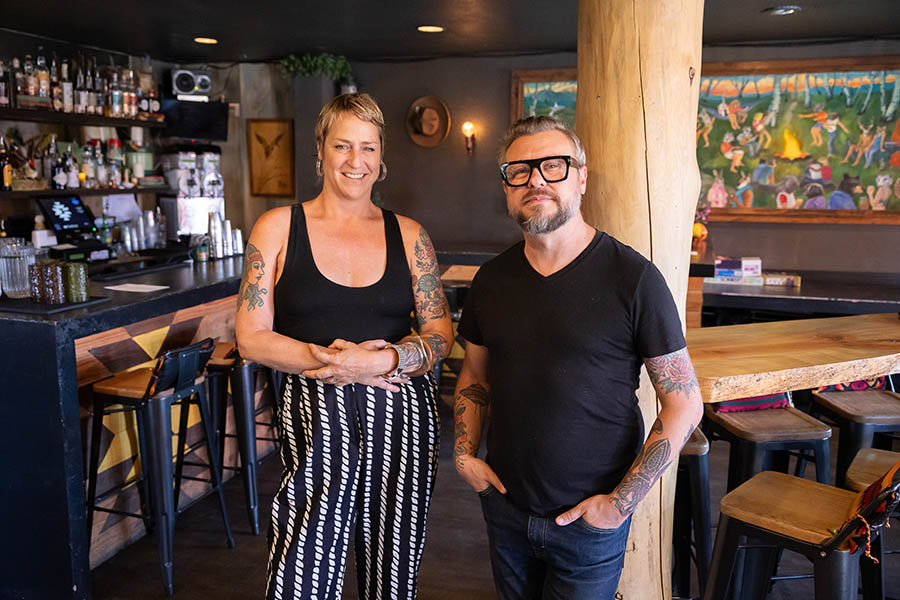
DVA Advertising also relocated into the district with a new 8,000-square-foot building that serves as a microcosm of what the city seeks, with professional offices sitting over a manufacturing warehouse and showroom for Imagine Stoneworks. Combined, the two businesses employ about 30 people, many of whom would prefer to walk to lunch and linger in the area after work. “I can tell you that Lucy’s Taco Shop, Laughing Planet and several food trucks in the area are definitely benefiting from our location here,” says DVA’s Justin Yax, one of four investors in the building. To get the Catalyst going, a site that will also include food and music about 100 paces away, Bend’s Sustainability Fund awarded Alexander a $450,000 grant. “It’s a project that will help make the area sticky,” Alexander says. “It gives people a reason to stay.”
It’s no secret that downtowns across the country are struggling to rekindle foot traffic as people work from home, a post-pandemic trend that has left prime, street-level commercial spaces around the nation boarded up and vacant. The BCD, however, offers the city a blank state to rethink how cities approach mixed-use development in an urban core.
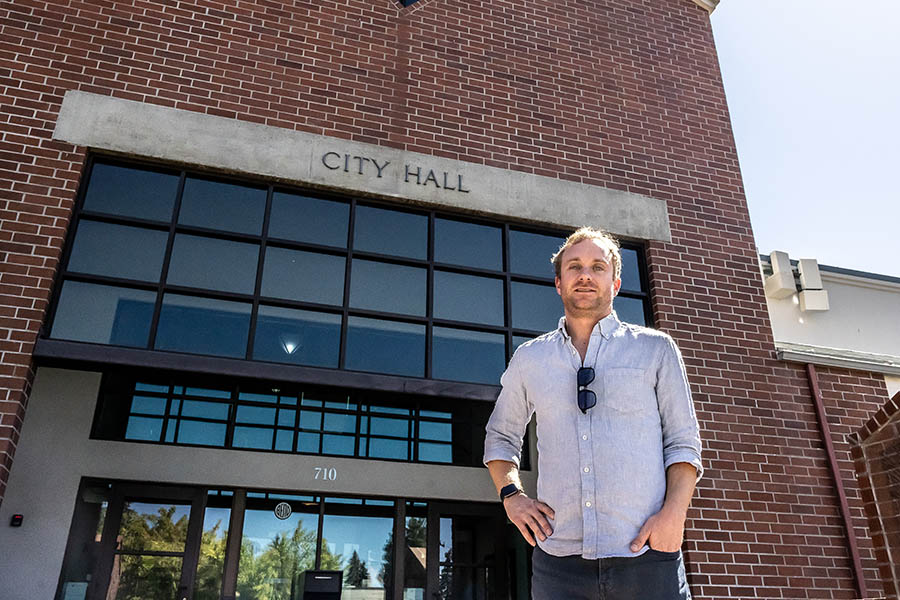
“These first five to 10 years are going to be pretty pivotal,” says Ben Hemson, the City of Bend’s economic development manager. “It’s like we’re in our 20s right now and figuring out how to invest in our 401(k)s so we can be sitting pretty down the road.”
Instead of working in vertical silos — think individual buildings with offices and apartments over retail and entertainment — Bend is trying to think horizontally, too. Picture a new apartment building next to an automobile mechanic who can afford to stay in the same garage the business has been in for 40 years. Thinking horizontally ultimately means finding ways to protect the industrial, maker-space nature that currently defines the area even as new infrastructure projects and a shift in zoning has primed the district for profitable redevelopment. Preserving that character helps create what Harlan refers to as “complete communities,” meaning neighborhoods with a wide range of services accessible by foot and bike to a diverse range of people and incomes.
“We want to make sure that the businesses that are there now can afford to be there in the future,” she says.
To do that, the city has created a zoning overlay that preserves existing light-industrial uses while also allowing dense mixed-residential developments. Meanwhile, the city’s Core Area Business Assistance Program supports businesses in the district looking to make internal and external improvements that would enhance the aesthetics of the area and improve customer experience, such as new signage or upgraded spaces. The program includes ways for business owners to get design help through grants ranging from $5,000 to $7,500. A second track offers grants up to $50,000 to offset construction costs. Another program, the Core Area Development Assistance Program, creates a pool of about $800,000 that can be awarded through grants and loans to help speed up housing and mixed-use projects. The first round of funding is on track to be awarded in November.
“What I think is really smart and great about this is how it’s meant to counter some of the gentrification and displacement that can happen with urban renewal,” Harlan says. “You want that character. As a business owner in the district told me, that diversity is what gives a neighborhood its patina.”
For the moment, though, the neighborhood is less weathered copper and more flaky rust. Challenges to its transformation remain with high construction costs, unfavorable interest rates and scores of small lots that make large-scale development difficult. Homelessness and security concerns add to the issues. To complicate matters, the city recently purchased the Rainbow Motel on Franklin Avenue with plans to convert it into a low-barrier shelter, at least temporarily. (Rumors abound that one day that shelter site could be home to a new City Hall.) For now, that shelter-to-be sits directly across from a site that Taylor Brooks, a joint venture between Taylor Development and Brooks Resources, had planned to use for a new five-story, 154-unit mixed-use residential building, a project that’s now on hold.
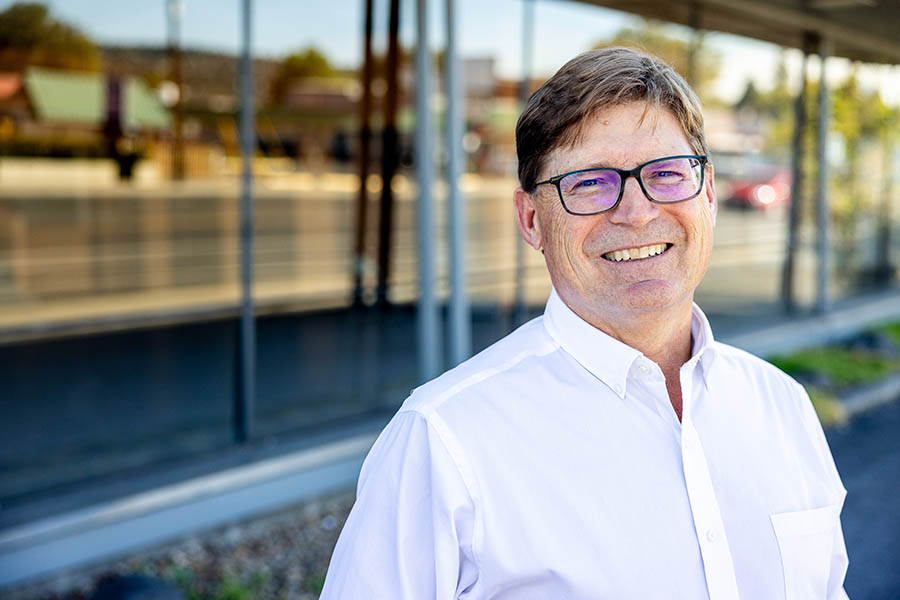
“We decided to pump the brakes on that,” says Kirk Schueler, president and CEO of Brooks Resources. The company is also waiting for infrastructure improvements to really get going, especially traffic-calming measures on Franklin Avenue that would make the area more attractive to potential residents. “Trying to cross the street there now is like Frogger,” he says.
There’s no doubt, however, that companies and developers remain deeply interested in the future of a district that will greatly alter the character of one of Oregon’s most popular places. It’s a district where small businesses like the Dogwood and DVA, as well as indoor plant shop, Somewhere That’s Green, and Big Story Bookstore, can all help set the tone for a new kind of downtown.
“I have no doubt that before too long people will call this” — the BCD — “downtown, and downtown will become Old Downtown,” Alexander says. “This is our chance to put on those big pants and become a small city. The change is upon us.”
Click here to subscribe to Oregon Business.

